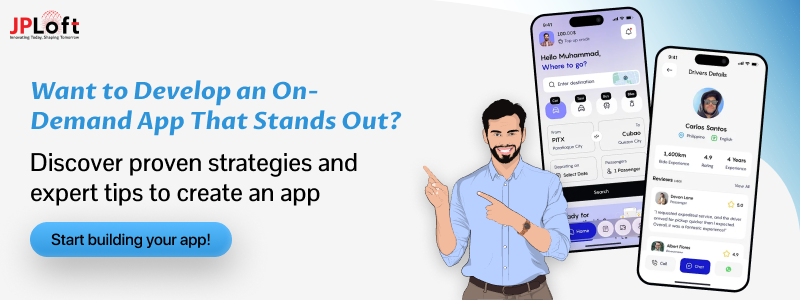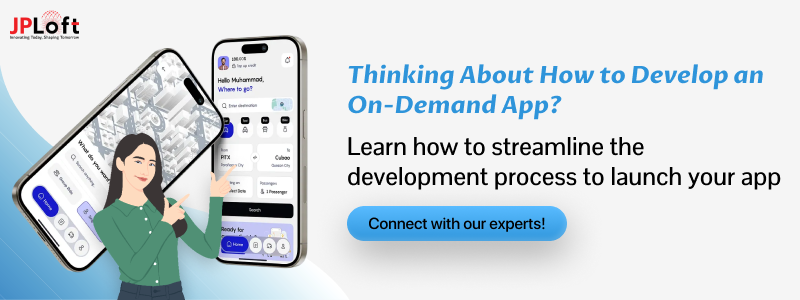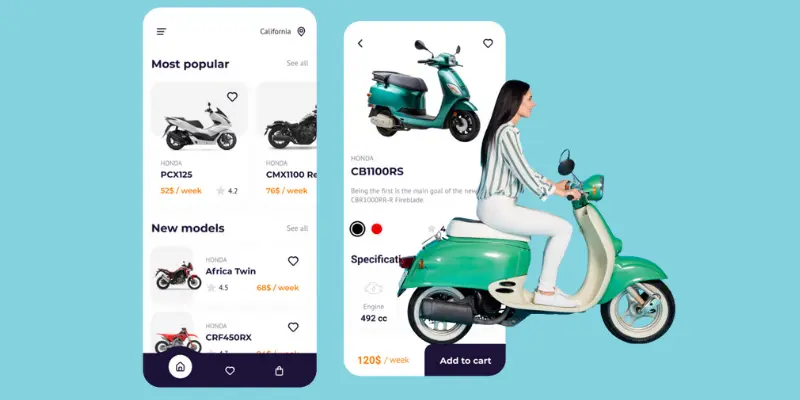Key Takeaways
To develop an on demand app, start with research and validation to identify real user problems, target audience, and market gaps before building your app.
Essential features like user registration, real-time tracking, secure payments, chat, ratings, and AI-driven recommendations are critical for user engagement and retention.
Intuitive design, seamless navigation, and a robust tech stack ensure smooth performance, scalability, and a superior app experience.
From MVP to enterprise-ready solutions, designing for scalability allows your app to expand into new regions, services, and user segments efficiently.
Commission-based systems, subscriptions, in-app ads, surge pricing, and featured listings are proven ways to generate revenue while keeping users satisfied.
Collaborating with a trusted on demand app development company like JPLoft ensures end-to-end solutions, advanced features, and a high-quality app for your business growth.
In 2025, the global on-demand app market is projected to surpass $350 billion, with industries like food delivery, healthcare, and home services leading the charge.
With this massive boom, many startups and enterprises are now asking, “How to develop an on-demand app?” The answer lies in understanding what users need and turning those needs into seamless, tech-driven experiences.
From booking cabs in seconds to getting groceries at your doorstep, on-demand apps are reshaping how businesses connect with customers. Whether you’re an entrepreneur or an established brand, building your own on-demand app can unlock limitless growth opportunities.
In this blog, we’ll explore everything you need to know to create an on-demand app, from core features and cost factors to step-by-step development strategies that guarantee success.
A Quick Look At On-Demand Apps
An on-demand app is a digital platform that connects users with specific services or products instantly, anytime, anywhere. Think about ordering food through DoorDash, booking a ride on Uber, or scheduling a home cleaning service, all of these are examples of on-demand apps simplifying daily life.
These apps work as a bridge between service providers and consumers, using smart technology and real-time tracking to ensure convenience, speed, and reliability. In simple terms, when you create a mobile app that fulfills an immediate customer need with just a few taps, you’re developing an on-demand solution.
Today, such apps have become the backbone of modern digital businesses, empowering startups and enterprises alike to meet evolving customer expectations with efficiency and ease.
The on-demand ecosystem is growing rapidly, and its adoption is being driven by increasing smartphone penetration, faster internet connectivity, and changing consumer preferences toward convenience and immediacy.
To give you a clearer picture of this booming market, here are some key statistics:
-
According to Market Research Insights, the global on-demand services market was valued at approximately $200 billion in 2024 and is projected to reach $210.8 billion in 2025, further expanding to $320 billion by 2033, growing at a CAGR of about 5.4% from 2025 to 2033.
-
A study by Business of Apps shows that in 2024, 137.8 billion apps and games were downloaded globally, a 1% decrease from the previous year.
-
As per Grand View Research, the global mobile application market size was estimated at $252.89 billion in 2023 and is projected to reach $626.39 billion by 2030, growing at a CAGR of 14.3% from 2024 to 2030.
-
Based on research by Market Us, the global print-on-demand app market size is projected to grow around USD 12.2 billion by 2033, from USD 2.9 billion in 2023, growing at a CAGR of 18.8% during the forecast period from 2024 to 2033.
-
Insights from Sensor Tower reveal that users download an average of 9.2 apps per month globally, indicating a high level of engagement with mobile applications.
These numbers clearly highlight the immense potential and rapid growth of the on-demand app market. With increasing user engagement and technological advancements, businesses that invest in developing an on-demand app today are well-positioned to capture a larger share of this expanding ecosystem.
As demand continues to rise, creating a robust, user-friendly, and feature-rich on-demand app is more crucial than ever for staying competitive in the digital landscape.
Why You Should Invest in On Demand App Development?
Imagine a world where your customers no longer wait in queues, make endless phone calls, or deal with service delays. That’s the transformative power of on demand app development, a model that has completely reshaped how businesses operate in today’s digital-first world.
From ordering groceries to booking a beauty service at home, users expect speed, convenience, and personalization at their fingertips. mene
If you’re planning to build an on-demand app, here’s why it’s one of the smartest business decisions you can make:
-
Rising Market Demand: The global on-demand economy is booming. With millions of daily transactions happening across various sectors, investing in on-demand app development allows you to tap into a thriving, future-ready market. Consumers love instant services, and your app could be their next favorite shortcut.
-
Scalable Business Model:Whether you start small or go big, an on-demand app grows with your business. With the right on demand app development strategy and support from a trusted AI app development company, you can easily add new services, expand regions, and enhance user experiences through smart, AI-driven features.
-
Multiple Revenue Streams: Unlike traditional businesses, on-demand apps open up several ways to generate income, subscriptions, commissions, delivery charges, and in-app advertisements. When you build an on-demand app, you’re not just creating a service; you’re building a sustainable source of recurring revenue.
-
Strong Customer Relationships: Nowadays, customer loyalty depends on how quickly and efficiently you solve their problems. By offering personalized, seamless experiences through on-demand app development solutions, you can build lasting connections that turn one-time users into lifelong customers.
In essence, investing in on-demand app development isn’t just about technology; it’s about turning innovative on-demand app ideas into convenience for users, capturing business opportunities, and building a brand that customers can’t imagine living without.
Features That Turn a Simple On-Demand App into a Market Winner
When it comes to building a successful app, “features” are what truly set you apart. You can have a great idea and design, but without the right on demand app development features, your app might never reach its full potential.
Think of these features as the “heart and brain” of your app, helping it run smoothly, attract users, and keep them coming back for more.
Whether you’re planning to create an on-demand app for food delivery, healthcare, or logistics, here are the core elements that can make your app shine in today’s competitive market.
|
Feature |
Description |
Why It Matters |
|
User Registration & Profiles |
Allows users to sign up easily using email, phone, or social media. |
Simplifies onboarding and builds personalized experiences. |
|
Real-Time Tracking |
Lets users track deliveries or service providers live on a map. |
Boosts transparency and trust among users. |
|
Secure Payment Gateway |
Enables multiple payment options with encryption for safety. |
Ensures smooth and secure transactions for users and service providers. |
|
In-App Chat & Notifications |
Allows real-time communication and timely alerts. |
Enhances user engagement and support. |
|
Ratings & Reviews |
Users can share feedback and rate services. |
Helps maintain service quality and builds credibility. |
|
AI-Powered Recommendations |
Suggests services or products based on user behavior. |
Makes the experience smarter and more personalized. |
|
Multi-Platform Support |
Works seamlessly across iOS, Android, and web. |
A must-have for any on-demand app development to reach wider audiences. |
|
Admin Dashboard |
Gives businesses control over users, services, and analytics. |
Helps manage operations efficiently and make data-driven decisions. |
When you include these features, you’re not just adding functionality, you’re creating a user experience that feels intuitive, reliable, and memorable. Each feature contributes to your business growth, making your app stand out as a true market winner in the world of on-demand app development.
Step-by-Step Guide to Develop an On-Demand App
Wondering exactly where to begin and how to turn your app idea into a fully functional on-demand solution? Developing an on-demand app can feel overwhelming at first, especially with so many features, platforms, and technical decisions to consider.
But the good news is, with a clear roadmap, you can create an on-demand app efficiently and strategically. Below are the core development steps, a clear roadmap to help you create and launch a winning on-demand app:
-
Research & Market Validation
-
Define Features & Choose Platform
-
UX/UI Design & Prototyping
-
Backend Architecture & APIs
-
Frontend Development (iOS, Android, Web)
-
Integrations (Payments, Maps, Notifications)
-
QA, Testing & Beta Launch
-
Deployment & App Store Submission
-
Post-Launch Monitoring & Iteration
-
Scale & Enterprise Solutions
Now let’s walk through each step in detail so you can confidently make an on-demand app that customers rely on.
Step 1: Research & Market Validation
Before you create an on demand app, validate your idea thoroughly. Study competitors, identify your target users, and understand the pain points you aim to solve. Ask yourself if there is a real demand for this service in your city, region, or niche?
This step also helps you identify gaps in the market that your app can fill. Market validation is crucial because it helps you decide whether to build an on-demand app as an MVP (minimum viable product) or invest in full-featured custom on demand app development.
Additionally, it gives insights into pricing, features, and user expectations, reducing risk and clarifying your value proposition before committing significant resources.
Step 2: Define Features & Choose Platform
Once you know your target audience, list the core features your app needs: registration, real-time tracking, secure payments, ratings, chat, and an admin dashboard. Decide whether you’ll launch on mobile (iOS/Android), web, or both.
If you want to reach a wider audience quickly, consider an on-demand platform development that supports multi-platform builds. For iOS-specific development, you may need to hire iOS app developers who can ensure smooth performance, seamless navigation, and compliance with Apple’s guidelines.
Define which features are essential for your MVP and which can be added later. This helps you save development time and cost while letting you build an on-demand app for business needs.
Step 3: UX/UI Design & Prototyping
Design is where ideas come to life. Map out user journeys for customers, service providers, and admins to understand interactions at every touchpoint. Build clickable prototypes and perform app wireframing to test flows like booking, checkout, tracking, and support.
A clean, intuitive UI is vital for on-demand mobile app development, as users expect speed, simplicity, and a seamless experience. Many businesses also collaborate with professional UI/UX design services to ensure their app is visually appealing, easy to navigate, and optimized for conversions.
Early app prototyping allows you to gather feedback, make design adjustments, and reduce costly changes during development. Think of this phase as creating the blueprint for your app, ensuring every screen, button, and interaction feels natural and satisfying to the user.
Step 4: Backend Architecture & APIs
The backend powers your app, handling user data, bookings, payments, matching algorithms, and analytics. Choose a scalable architecture, microservices or modular monolith and implement secure, well-documented APIs.
If you want to build an on-demand app that scales to multiple cities or enterprise clients, your backend should support growth without compromising performance.
Consider real-time services like WebSockets for live tracking, push notifications, and automated alerts. A robust backend ensures that your on-demand app development process results in a responsive, secure, and reliable application that can handle increasing user loads seamlessly.
Step 5: Frontend Development (iOS, Android, Web)
The frontend is where users interact with your app. Decide whether to implement native apps for iOS/Android or use cross-platform frameworks depending on budget and performance goals.
Native apps deliver superior speed and responsiveness for real-time features, while cross-platform approaches allow faster deployment across multiple platforms. If you want to create an on-demand app with a flawless frontend, consider partnering with the best mobile app development company.
Their expertise ensures smooth animations, minimal load times, and intuitive navigation across devices.
Step 6: Integrations (Payments, Maps, Notifications)
Integrate secure payment gateways, mapping systems for routes and ETAs, SMS/email notifications, and in-app alerts.
These integrations make your app functional, reliable, and user-friendly, key components of any successful on-demand app development.
Also, plan for KYC or verification flows for service providers if applicable, and include analytics tools to track engagement and performance.
These integrations ensure you create an on-demand app that’s not only feature-rich but also trustworthy and efficient for both users and providers.
Step 7: QA, Testing & Beta Launch
App testing is a critical stage in the development process of on-demand app. Conduct functional, usability, performance, and security testing to uncover issues before launch.
Launch a closed beta with a small group of users to gather real feedback, observe behavior, and identify pain points. Beta testing helps refine features and optimize user experience, ensuring your app works smoothly under real-world conditions.
This step guarantees that your final product is stable, polished, and ready to delight users once you officially make an on-demand app live.
Step 8: Deployment & App Store Submission
Prepare your app for release by creating store listings, screenshots, privacy policies, and ensuring compliance with Google Play and Apple App Store guidelines. For iOS, you will need to submit an iOS app to the App Store, following Apple’s review process and guidelines carefully.
Deploy your web app in a secure, scalable hosting environment. For Android, make sure to publish apps to the Google Play Store while accounting for regional compliance, store requirements, and testing.
A smooth deployment ensures your users get a reliable app experience and sets the stage for immediate engagement, downloads, and long-term retention.
Step 9: Post-Launch Monitoring & Iteration
Once your app is live, continuous app maintenance service and performance metrics such as crashes, user behavior, retention rates, and conversions. Use analytics to track drop-off points and heatmaps to understand interactions.
Iterate quickly by releasing updates that improve performance, add high-impact features, and enhance user satisfaction.
Consistent optimization ensures that your app remains competitive and provides a superior experience, turning your initial launch into a trusted, widely-used on-demand app development solution.
Step 10: Scale & Enterprise Solutions
After achieving product-market fit, focus on scaling your app. Expand to new geographies, add more verticals, and offer enterprise on-demand app solutions for B2B clients.
Consider advanced features like SLA management, bulk onboarding, white-label options, and analytics dashboards to support larger operations. Partnering with specialists can help startups build an on-demand app for startups that is enterprise-ready.
Scaling ensures long-term growth, making your app a sustainable business asset rather than just a one-time launch product.
This step-by-step guide to create an on-demand app gives you a practical roadmap, from validating your idea to scaling enterprise-ready solutions.
If you’re looking for professional guidance, partnering with a reliable mobile app development company in Denver can help you implement best practices, leverage advanced technologies, and launch a high-quality app that meets both user expectations and business goals.
Tech Stack for Developing an On-Demand App
Building a successful on-demand app isn’t just about design or features, it’s about choosing the right mobile app tech stack that ensures speed, scalability, and security.
If you’re planning to develop an on demand app in-house, selecting reliable technologies will shape the performance and future growth of your app.
Below is the suggested tech stack that powers modern on-demand app development solutions across iOS, Android, and web platforms.
|
Component |
Technologies / Tools |
Purpose |
|
Frontend (Mobile) |
Swift (iOS), Kotlin (Android), Flutter, React Native |
App interface, performance, and smooth UX |
|
Backend |
Node.js, Django, Laravel, Ruby on Rails |
Server-side logic, APIs, and data management |
|
Database |
PostgreSQL, MongoDB, Firebase |
Secure data storage and real-time syncing |
|
APIs & Integrations |
REST, GraphQL, WebSockets |
Enables communication between systems |
|
Payment Gateways |
Stripe, PayPal, Razorpay |
Secure in-app payments |
|
Maps & Navigation |
Google Maps, Mapbox |
Location tracking and route optimization |
|
Authentication |
Firebase Auth, OAuth 2.0 |
Secure user login and identity management |
|
Push Notifications |
Firebase Cloud Messaging, OneSignal |
Real-time alerts and updates |
|
Cloud & Hosting |
AWS, Google Cloud, Microsoft Azure |
Scalable infrastructure and hosting |
|
Analytics |
Google Analytics, Mixpanel |
Performance tracking and user insights |
Choosing the right tech stack lays the foundation for app reliability and long-term growth. With the right combination of tools and frameworks, you can ensure seamless performance, enhanced user experience, and effortless scalability.
Investing time in selecting the ideal technology stack today will help you build a future-ready, high-performing app that stands strong in a competitive digital market.
How Much Does It Cost to Develop an On-Demand App?
One of the most common questions businesses ask is “What’s the real cost to create an app like Uber, Zomato, or UrbanClap?” The truth is, there’s no fixed number.
The cost to develop an on demand app varies widely based on factors such as app complexity, feature set, design quality, chosen platform, and the region where your development team operates.
On average, developing a custom on-demand app can range between $20,000 – $300,000. Building a simple MVP version with basic features like registration, payments, and tracking will cost significantly less than a feature-rich platform with AI integration, real-time analytics, or advanced user personalization.
The cost to create an app also depends on whether you’re hiring freelancers, an in-house team, or partnering with a professional app development company that handles end-to-end services.
Now, let’s break down all these factors in detail to understand what truly influences the overall on-demand app development cost.
|
App Type |
Development Complexity |
Estimated Cost (USD) |
|
Basic On-Demand App (MVP) |
Simple features, single platform |
$20,000 – $50,000 |
|
Moderate App (Multi-Platform) |
User dashboard, payments, tracking |
$50,000 – $120,000 |
|
Advanced App (Full-Featured) |
Real-time tracking, AI chat, analytics |
$120,000 – $200,000 |
|
Enterprise-Level Solution |
Custom integrations, multi-region support |
$200,000 – $300,000+ |
Remember, the total investment doesn’t just cover coding; it includes UI/UX design, QA testing, post-launch support, and regular updates.
To optimize costs, you can start with an MVP version and scale gradually as your user base grows.
Choosing a trusted app development company ensures you get the best value for every dollar spent, with quality, scalability, and performance built in from day one.
Major Challenges in Creating a Successful On-Demand App
Ever wondered why some on-demand apps thrive like Uber or Swiggy, while others fail to take off? The truth is, building a successful on-demand app comes with its own set of challenges that go beyond just coding or design.
Here are some of the most common hurdles developers and businesses face during on-demand app development:
-
Managing Real-Time Data: Handling instant updates like order tracking, ride status, or delivery timing demands a highly optimized backend. Even a few seconds of delay can affect the user experience.
-
Ensuring Scalability: As your user base grows, your app should perform smoothly without downtime. Choosing the right tech stack is crucial to ensure long-term scalability.
-
Integration Complexity: Integrating payment gateways, GPS, chat support, and analytics tools can cause bugs if not done properly, affecting app stability and reliability.
-
User Retention & Engagement: Acquiring users is one thing, but keeping them engaged with loyalty programs, rewards, and personalized offers is the real challenge.
-
Security & Data Privacy: On-demand apps deal with sensitive user data and transactions, so maintaining high-level data security standards is non-negotiable.
Overcoming these challenges with expert guidance, strategic planning, and robust technologies can turn your on-demand app idea into a long-term business success.
To ensure top-quality development and timely delivery, you can also hire dedicated developers who specialize in building scalable, feature-rich on-demand apps.
The Future of On-Demand Apps: Key Trends to Watch
The on-demand economy is evolving faster than ever. Businesses that adapt early to emerging technologies are the ones that stay ahead.
Here are the top future trends shaping on-demand app development in the coming years:
► AI and Machine Learning for Personalization
AI-driven recommendations enhance customer experiences by understanding preferences. Many businesses now build an AI app to deliver personalized and predictive services efficiently.
From suggesting nearby services to optimizing delivery routes, AI is transforming the way users interact with on-demand apps.
► Voice and Chatbot Integration
Voice assistants and intelligent chatbots allow users to book, order, or schedule services hands-free, making interactions faster and more convenient.
These tools also provide instant support, answer queries, and guide users through complex workflows, improving overall user satisfaction and reducing response times.
► Blockchain for Secure Transactions
Blockchain technology is revolutionizing on-demand finance and logistics apps by providing secure, tamper-proof transactions. It ensures transparency, builds trust between service providers and users, and minimizes fraud risks while streamlining payment processes.
Many businesses partner with a professional Blockchain development company to implement these solutions effectively and securely within their on-demand apps.
► Cross-Platform Development with Flutter & React Native
Frameworks like Flutter and React Native help businesses reduce time-to-market while maintaining a consistent experience across Android, iOS, and web platforms.
They also allow for easier updates and scalability, making them ideal for startups and growing enterprises alike.
► IoT Integration for Smart Services
IoT devices enable apps to connect with smart homes, vehicles, and wearable gadgets, offering real-time data and seamless automation. On-demand apps leveraging IoT can provide advanced features like automated deliveries, smart scheduling, or predictive maintenance services, enhancing overall efficiency.
Businesses often rely on expert IoT app development services to seamlessly incorporate smart solutions into their on-demand apps, ensuring efficiency and reliability.
► AR & VR Experiences
Augmented and virtual reality are creating immersive experiences within on-demand apps. From virtual try-ons in fashion and retail apps to AR navigation aids for deliveries, these technologies are helping apps engage users more interactively and realistically.
Many businesses now leverage professional AR/VR app development services to integrate these advanced features seamlessly into their on-demand platforms.
► Hyperlocal Service Optimization
On-demand apps increasingly rely on location intelligence to offer faster, more precise services tailored to local demands.
By optimizing routes, predicting demand hotspots, and suggesting nearby providers, apps can enhance efficiency and reduce wait times for users.
As the future unfolds, on-demand app development will continue merging automation, intelligence, and user-centric design to deliver faster, smarter, and safer digital services.
Businesses that adopt these emerging technologies early will gain a competitive edge, retain users longer, and create innovative solutions that redefine customer experiences.
Best Monetization Strategies for On-Demand Apps
Once your app is ready, the next big question is “How can I turn my on-demand app into a profitable business?” So, you can turn it into a profitable business by implementing effective mobile app monetization strategies that generate steady revenue while enhancing user experience.
Let’s explore the most effective models that successful companies use to make money:
- Commission-Based Model: Platforms like Uber and UrbanClap use this approach; they charge a small commission from every transaction between the service provider and the customer. It’s scalable and ensures steady earnings.
- Subscription Plans: Offering premium subscriptions gives users access to exclusive features like faster delivery, priority booking, or ad-free usage. This model builds consistent monthly or yearly revenue.
- In-App Advertising: Partnering with relevant brands for targeted ads allows you to earn without charging users directly. However, maintaining balance is key to avoiding a disturbing user experience.
- Surge Pricing & Dynamic Rates: Used widely in ride-sharing and delivery apps, surge pricing adjusts costs based on demand. It increases profits during high-demand periods without changing app structure.
- Featured Listings or Promotions: For service-based apps, offering paid promotions or top placements for vendors boosts their visibility while adding extra revenue to your business.
By combining these strategies with seamless performance and user trust, your on-demand app can achieve both growth and profitability in the competitive digital landscape.
Partner with JPLoft for Expert On-Demand App Development
When it comes to building a robust and feature-rich on-demand app, partnering with the right team is critical. JPLoft is a leading on-demand app development company that specializes in delivering custom solutions tailored to your business needs.
From concept validation to UI/UX design, backend development, and post-launch support, our experts ensure every step of the on-demand app development process is executed seamlessly.
Whether you aim to launch a startup MVP or an enterprise-level platform, JPLoft provides scalable, secure, and innovative solutions to help you succeed in the competitive on-demand market.
Our team leverages the latest technologies, integrates advanced features, and follows industry best practices to create apps that engage users, drive retention, and maximize profitability.
Final Wrap-Up
Developing an on-demand app is more than just coding, it’s about understanding market needs, implementing the right app development features, and creating a seamless user experience.
From researching your idea to scaling enterprise-ready solutions, following a structured guide to develop an on-demand app can significantly enhance your chances of success.
By leveraging emerging trends, choosing the right tech stack, and implementing smart monetization strategies, businesses can create apps that not only solve real-world problems but also generate sustainable revenue.
With professional guidance, you can make an app that stands out in the competitive digital landscape and delivers value to users consistently.
FAQs
An on-demand app is a mobile or web platform that connects users with services or products instantly, like ride-hailing, food delivery, or home services.
The cost depends on features, platform choice, design complexity, and development location, typically ranging from $20,000 to $300,000.
Depending on complexity and features, development can take 3–9 months from concept to launch.
Core features include registration, real-time tracking, secure payments, ratings, chat support, and an admin dashboard.
Popular monetization strategies include commissions, subscription plans, in-app advertising, surge pricing, and featured listings.













Share this blog